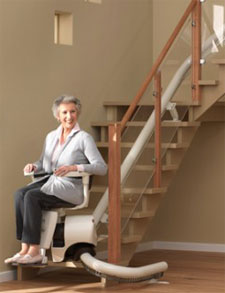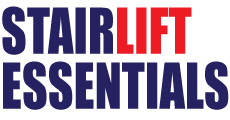What a curved stairlift is
A curved stairlift is one of the two main types of stairlifts that you can install in your house. The other main type being a straight stairlift.
Although they both do exactly the same thing (i.e. move people up and down the stairs), the main difference between the two is on the type of rail/track that they run on.
In this short article, I will explain what a curved stairlift is, for what type of stairs they are suitable for and the advantages and disadvantages of having this type of stairlift.
What is a curved stairlift?

It is stairlift which runs on a piece of rail/track that can be curved (hence its name).
What type of staircase it is suitable for
It is suitable for any type staircase. They are normally designed to be installed on staircases which are either curved or have a bend in them, but they can equally be installed on staircases which are straight (although a straight stairlift is normally installed on these type of staircases).
When not in use, the carriage (where you sit) of a curved stairlift is normally parked like a straight stairlift either at the bottom in the hallway before the actual staircase starts or at the top over the last steps of the staircase, level with the landing.
But with a curved stairlift you can also park (and get on or off) the stairlift around the side of the staircase (at either the top or bottom) or further away from the beginning or ending of the staircase. For example, you can park the stairlift on the actual landing and not over the last step of the staircase.
Advantages
As I talked about above, the main advantage of a curved stairlift is the flexibility you have where you park (and get on or off) the stairlift. Because the rail/track can curve, you have more options to where you can actually park it (e.g. around the side of the staircase, on the actual landing etc... ) than you do with a straight stairlift.
This flexibility means that a curved stairlift can often be installed on either side on a staircase. It also means that it is less likely to cause obstructions at either the top or bottom of the staircase when parked than a straight stairlift could do (like blocking a door or having a rail/track that can be easily tripped over).
Disadvantages
The main disadvantage is cost. Buying a curved stairlift is at least double the price of fitting a straight stairlift. The main reason why is that each rail/track on a curved stairlift has to be custom manufactured to fit the exact measurements of your staircase. This price can rise further if you want the stairlift to be parked around the side of the staircase or on the landing.
As the rail/track has to be custom made by the manufacturer, you will have to wait longer to have a curved stairlift installed than if you bought a straight stairlift. You are looking at waiting at least a week (and probably longer) after you have bought it before it is installed. It also takes longer to install than a straight stairlift (you are looking at around 6 to 8 hours depending on your staircase and order).
With a curved stairlift, you are normally unable to buy a stairlift carriage that allows you to move on the stairs in a standing position (called a 'perch stairlift'). The vast majority of curved stairlifts are for a seated only position.
The last disadvantage is with reselling the stairlift when it is no longer wanted. Although it is possible to sell the carriage of the stairlift (i.e. the seat and the motor), because the rail/track is custom made for each individual staircase, it is impossible to resell that. As a result, you will get very little money back when you sell it.
In conclusion
So that's what a curved stairlift is. They are designed to be installed on staircases which have a bend in them or are curved. Unless it is your only option, I would not recommend that you install a curved stairlift on a staircase that is straight. They cost substantially more than a straight stairlift and you will only be able to sell the carriage part of the stairlift (where the seat and motor is) when you no longer want it.

